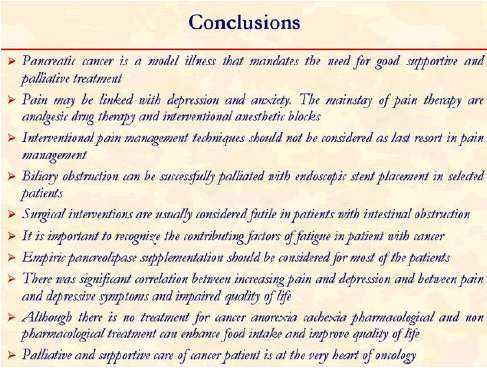- (2007) Volume 8, Issue 2
Salman Fazal, Muhammad Wasif Saif
1Griffin Hospital. Derby, CT, USA
2Yale University School of Medicine. New Haven, CT, USA
Received December 15th, 2006 - Accepted January, 16th
Cachexia; capecitabine; Cholestasis; Depression; Exocrine Pancreatic Insufficiency; gemcitabine; Intestinal Obstruction; Jaundice; Nerve Block; Pain; Pancreas; Pancreatic Neoplasms; Stents
SES: self expandable stents; SSRI: selective serotonin reuptake inhibitor
Pancreatic cancer is one of the most lethal malignancies. An estimated 32,300 patients will die of pancreatic cancer in year 2006. It is the tenth most common malignancy in the United State. Despite recent advances in pathology, molecular basis and treatment, the overall survival rate remains 4% for all stages and races. Palliative care represents an important aspect of care in patient with pancreatic malignancy. Identifying and treating disease related symptomology are priorities. As a physician taking care of these patients it is essential to know these symptoms and treatment modalities. This review discusses symptom management and supportive care strategies. Common problems include pain, intestinal obstruction, biliary obstruction, pancreatic insufficiency, anorexia-cachexia and depression. Success is needed in managing these symptoms to palliate patients with advanced pancreatic cancer. Pancreatic cancer is a model illness to learn the palliative and supportive management in cancer patient. It is important for oncologists to recognize the importance of control measures and supportive measures that can minimize the symptoms of advanced disease and side effects of cancer treatment.
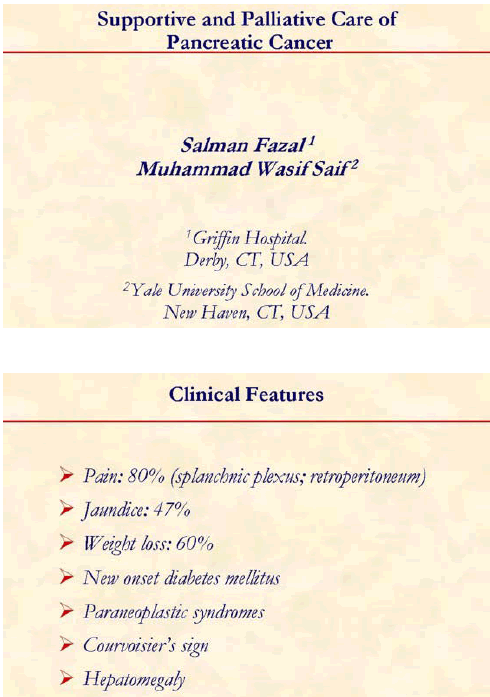
The presenting symptoms of pancreatic cancer can include pain, unexplained weight loss, nausea, vomiting, steatorrhea, dyspepsia, depression and jaundice. There are no well known warning signs of pancreatic cancer. However, new onset diabetes in an old patient has been associated with pancreatic cancer. Although painless jaundice is often thought as the typical presentation of pancreatic cancer, most of the patient have mild to moderate abdominal pain. Back pain usually suggests involvement of retroperitoneal nerves. Jaundice usually develops in patient with tumor in the head of pancreas, on the other hand , tumor in the tail of pancreas do not present with jaundice. Paraneoplastic syndromes may manifest as depression or thrombophlebitis. On physical examination, about 50% of patients have jaundice. Occasionally they may have palpable gall bladder (Courvoisier’s sign). Hepatomegaly may be present due to metastatic liver disease.
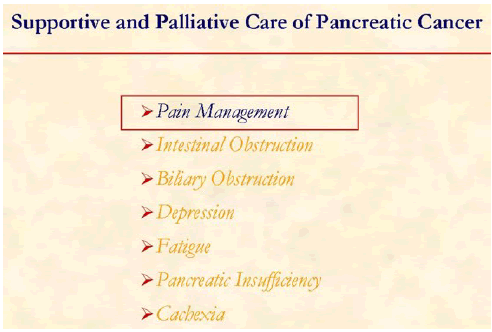
Prompt management must include efforts to palliate patients with advanced pancreatic cancer. Common problems include biliary obstruction, depression, pain, intestinal obstruction, and fatigue.
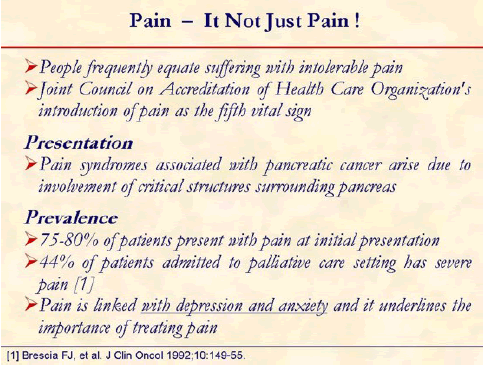
Pain is the most treatable cancer complaint. In patients with pancreatic cancer, it can arise due to involvement of the critical structures such as: the duodenum, liver, stomach, jejunum and transverse colon. Patients with obstruction of the intestines would develop colicky pain with abdominal distention. Involvement of the liver produce right upper quadrant pain and sometimes referred pain to the right shoulder or neck. Pain is usually worrisome for both patient and family. Some people would equate the suffering with intolerable pain. [1]
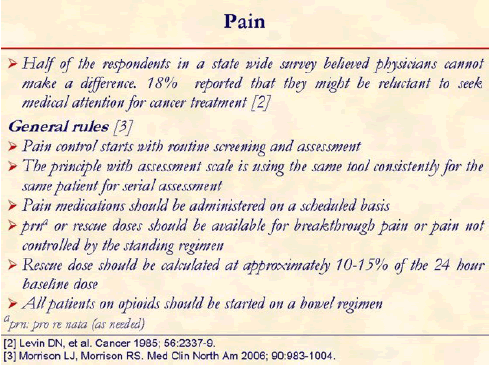
These are general rules in managing patient with cancer pain. Pain is subjective sensation and cannot be objectively validated. In order to assess the pain, physicians have to rely on self reporting from the patients. Multiple tools are available to assess the severity of the pain. However the important principle is to use the same assessment scale consistently for serial evaluation. Fortunately when pain is recognized, in more than 80% of patient it can be brought under control with basic management. [2, 3]
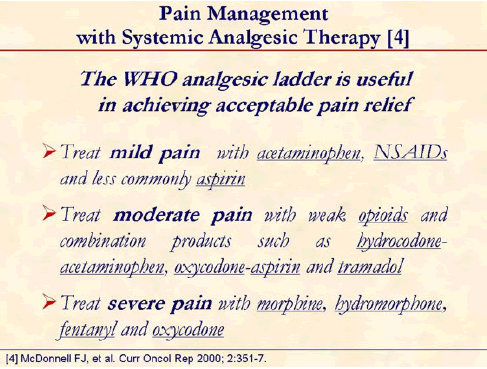
In addition to above medications steroids, anticonvulsants, antidepressants and biphosphonates can be useful in managing pain. [4]
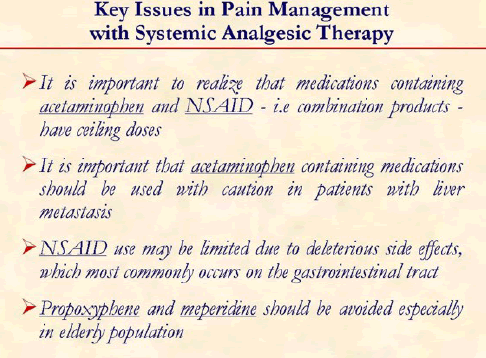
NSAIDs are the first line agents for managing mild pain. Their use may be limited due to potential deleterious side effects. Patients should be evaluated for risk factors to develop serious side effects. Patients who are above 60 years, on concurrent anticoagulation, steroid therapy, or with the past history of gastrointestinal bleeding are more prone to develop serious gastrointestinal side effects. Acetaminophen should be administered in dose less than 4 g/day. However physicians need to be more cautious in patients with alcoholic liver disease or hepatic metastasis. Propoxyphene and meperidine should be used with caution in elderly as its metabolites may build up to cause neurotoxicity and lower the seizure threshold.
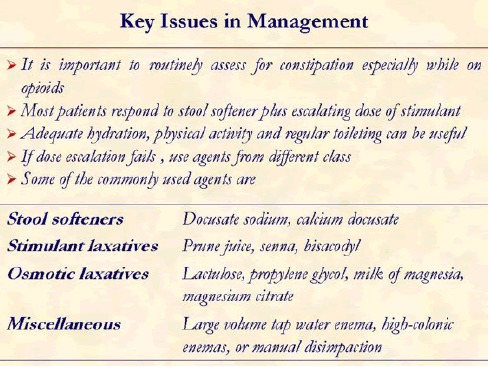
Sedation and nausea are common opioids side effect but usually patients develop tolerance to them. Constipation can be fairly common problem in patients receiving opioids for pain control. Patients underreport constipation and life threatening complications of fecal impaction and perforation can develop quickly if bowel movements are not maintained. Constipation is a side effect of opioids to which very few people show tolerance. For this reason, all patients on opioids need to receive a prophylactic bowel regimen of a stool softener and stimulant laxative, unless contraindicated.
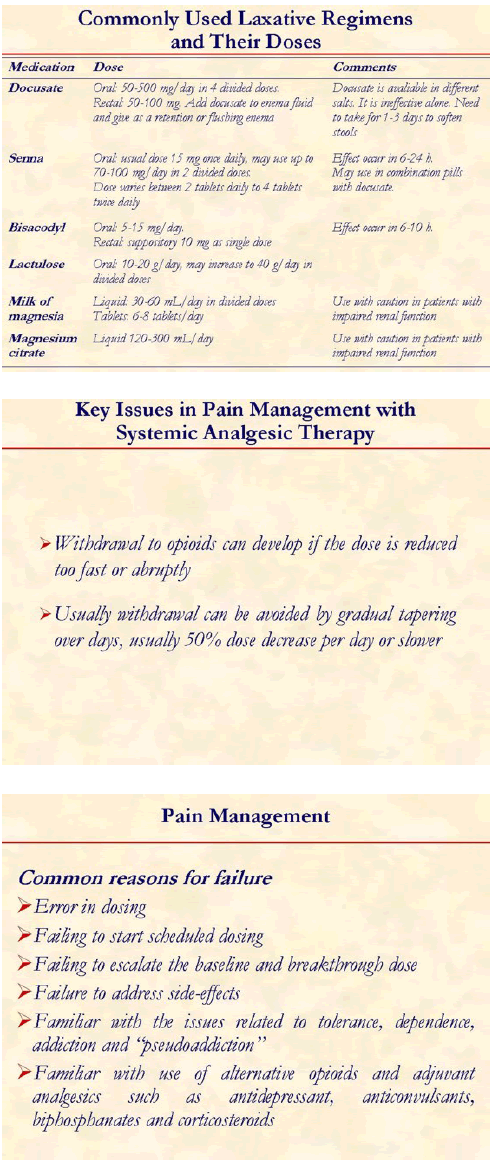
It is important to know the common reasons for inadequate pain control. Pain control is better with scheduled or around the clock dosing. Tolerance and dependence are pharmacological properties of pain medications. Pseudoaddiction refers to iatrogenic phenomenon resulting from poorly controlled pain. Patient exhibit features like frequent clock watching and repeated requests for pain medication. The behavior usually disappears after the pain is adequately controlled.
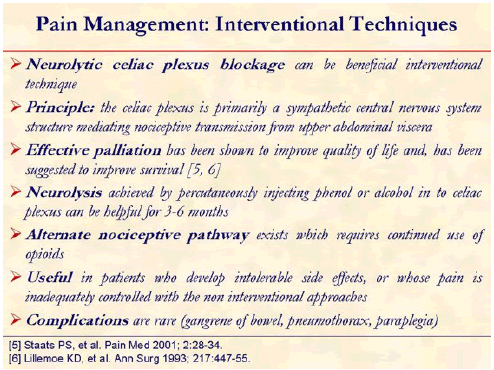
We have interventional pain management techniques. It is important to realize that they are not the last resort, but a valuable tool in the optimal care of cancer patients. One major interventional modality for pain control is anesthetic block of celiac plexus. The effect is unfortunately not permanent and severe pain can return after a variable interval (3-6 months). The neurological complications associated with neurolytic celiac block engenders the greatest concern. Orthostatic hypotension can happen in 1-3% of patients and usually lasts up to 5 days. Diarrhea (38%) may result from sympathetic blockage to the GI tract. Abdominal aortic dissection and retroperitoneal hemorrhage are rare complications. [5, 6]
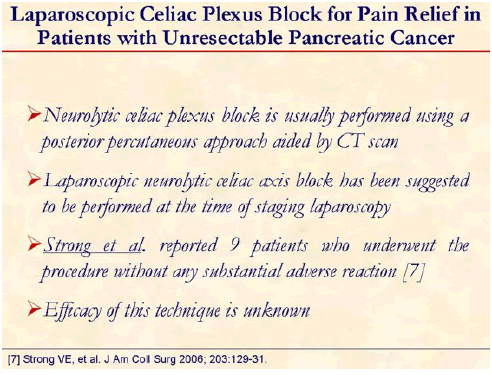
Neurolytic celiac plexus block is usually performed using a posterior percutaneous approach aided by CT scan. On the other hand, laparoscopic neurolytic celiac axis block can be performed at the time of staging laparoscopy. [7]
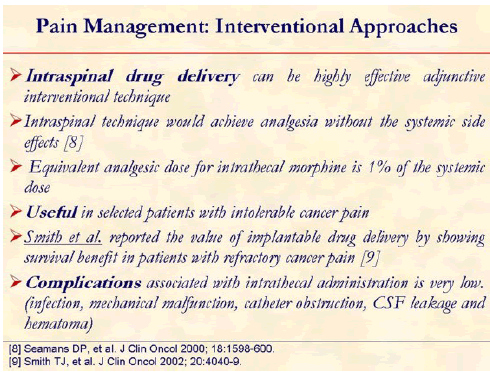
Intraspinal drug delivery via intrathecal or epidural route can be useful interventional technique. It allows to decrease the systemic side effects of oral opioids therapy. The economic issue can be an additional consideration favoring its use over the systemic analgesic therapy. However, intraspinal drug delivery cannot be provided without a proper team. [8, 9]
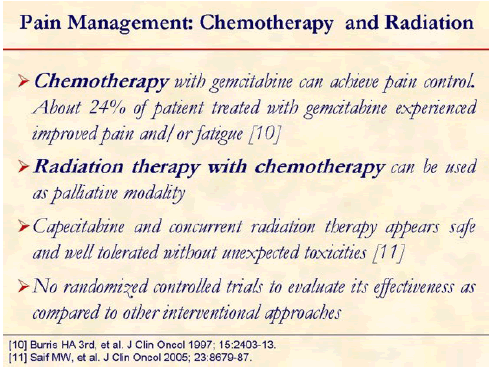
Chemotherapy can be helpful in controlling pain and fatigue. External beam radiation with chemotherapy can be used. However, the pain control may take several weeks. Study done by Saif et al. demonstrated the safety of using radiotherapy with capecitabine for locally advanced pancreatic cancer. [10, 11]
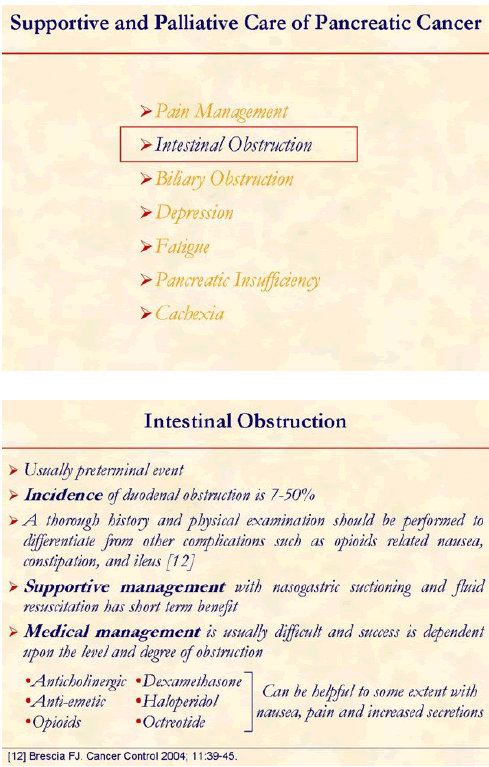
Intestinal obstruction is a late complication of advanced pancreatic cancer. It is important to evaluate for other causes which can present in similar way. Nasogastric suctioning can decompress the bowel and relieve some of the abdominal distention and pain. Pharmacological interventions can be helpful to some with intestinal obstruction, nausea and increased intestinal secretions. [12]
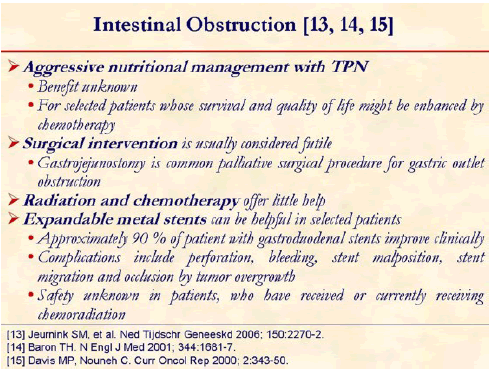
No data are available to support the use of aggressive parenteral nutrition in patient with advanced terminal disease. The advantage of surgical intervention such as gastrojejunostomy is long term efficacy. A disadvantage is prolonged postoperative course. Endoscopic stent placement can be helpful in some non-surgical patients with gastroduodenal obstruction. Patients may resume oral intake almost immediately after the successful stent placement. However, some patients may not improve after the stent placement. They may have obstruction at multiple level, or functional obstruction due to gastrointestinal dysmotility. Around 20% of patients require re-intervention because of recurrent symptoms. [13, 14, 15]
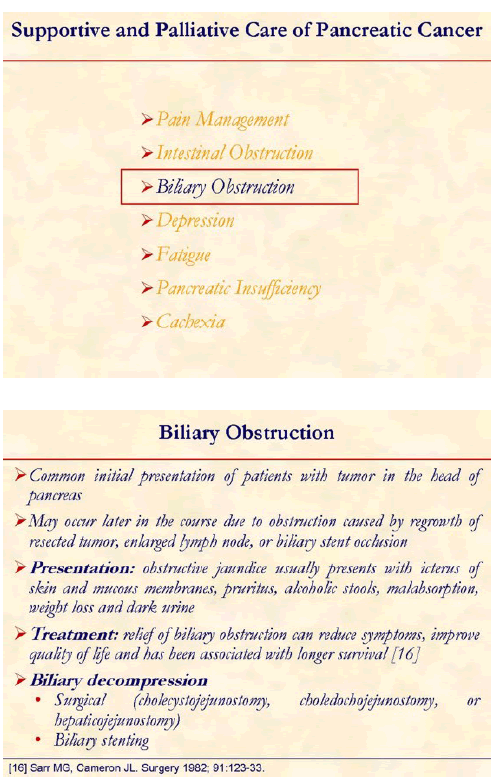
Around 90% of patients will have jaundice during some stage of their illness. The optimal management of these patients will vary depending upon their age, life expectancy, performance status, potential resectability of the tumor and physician’s expertise. Surgical decompression may be the best option for patient undergoing laparotomy for potential resection. Biliary bypass has been associated with improved survival and higher quality of life as compared to diagnostic laparotomy. [16]
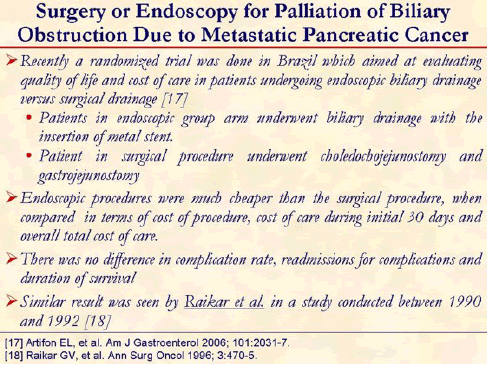
It is commonly believed that surgical drainage are cheaper palliative procedure. In a prospective, randomized controlled trial conducted in a tertiary referral center in Brazil, quality of life and cost of care were evaluated [17]. Patients with biliary obstruction due to metastatic pancreatic cancer and liver metastasis (without gastric outlet obstruction) were included in the study. Endoscopic biliary drainage with the insertion of a metal stent into the bile duct was compared with the surgical drainage procedure (choledochojejunostomy and gastrojejunostomy). Both surgical and endoscopic drainage procedures were successful, without any mortality in the first 30 days. The cost of biliary drainage procedure, the cost of care during the first 30 days after drainage, and the overall total cost of care were lower in the endoscopy group compared with the surgical group. In addition, the quality of life scores were better in the endoscopy group at 30 days (P=0.042) and 60 days (P=0.05). There was no difference between the two groups in complication rate, readmissions for complications, and duration of survival. Similar result was seen by Raikar et al. in a study conducted between 1990 and 1992 [18].
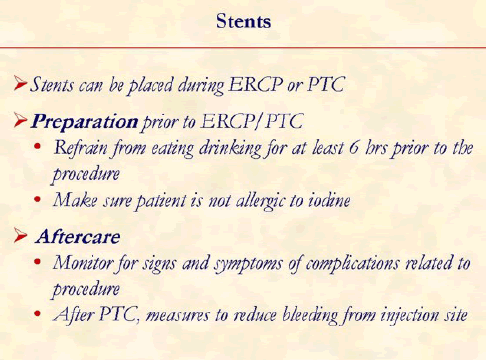
Biliary stenting can be done by ERCP (endoscopic retrograde cholangiopancreatography) or PTC (percutaneous transhepatic cholangiopancreatography). ERCP is an imaging technique used to diagnose diseases of hepatic and pancreaticobiliary origin. It usually involves inserting an endoscope into patient’s mouth. After visualizing the biliary duct orifice, a cannula is inserted, which is then used to inject dye into biliary system. Xrays are then taken to visualize any pathology of biliary system. Special instruments are used to place stents. PTC is similar to ERCP, however it is usually reserved for patients who cannot undergo ERCP. It involves inserting a needle thru the skin and reaching liver. Dye is injected into the biliary system. Stents can also be placed after visualizing level of obstruction. Prior to the procedure, patients are usually made npo (nothing by mouth) at least 6 hours prior to the procedure. Antibiotics will be started prior to the surgery and continued for several days afterwards. After the ERCP, patient usually stays in the hospital or outpatient facility until the effects of the sedative wear off and to ensure no complications occur. After PTC, the patient is instructed to lie on his or her right side for at least 6 hours to reduce the risk of bleeding. Patients should be frequently assessed to assess that the stent is functioning properly.
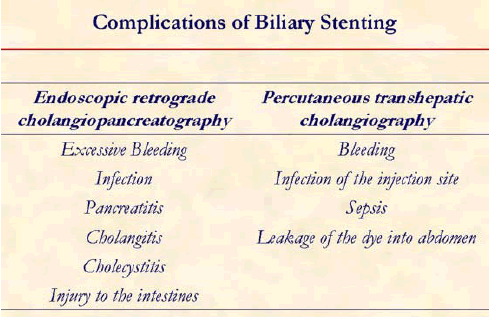
The rate of serious complications with ERCP is approximately 11%, and 5-10% with PTC. Complications related to stent are note mentioned over here.
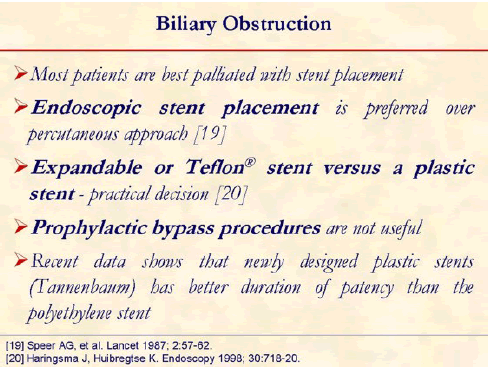
Most patients are best palliated by stent placement (endoscopic or percutaneous) due to its lower complication rate and lower cost. Endoscopic stenting has higher success rate and lower 30 day mortality rate. Plastic stents have more complications, but they are removable. So they are more viable option in patients who are getting neoadjuvant chemoradiation therapy. On the other hand, metallic stents are more durable and are recommended in patients with metastatic or unresectable cancer. [19, 20]
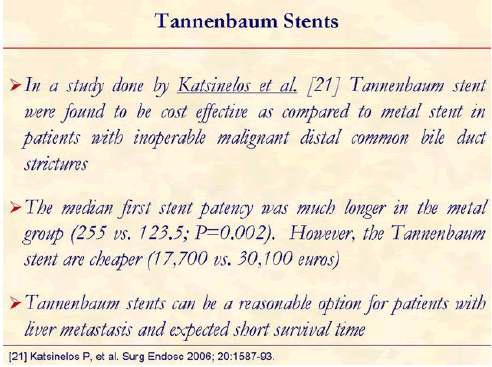
At the time of diagnosis more than 80% of patients with malignant obstructive jaundice cannot undergo operative resection. Endoscopic intervention with stenting is an important palliative technique. However stent clogging is the major limitation. Metal stents have better patency than the plastic stent, however they are more expensive. In a study done by Katsinelos et al. Tannenbaum stent were found to be cost effective as compared to metal stents [21].
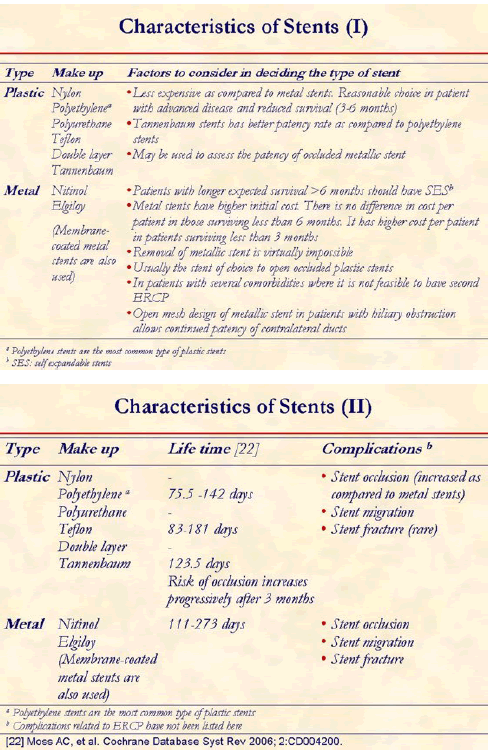
Endoscopic biliary drainage using the stents are effective way to palliate the patients with biliary obstruction. Plastic stents in sizes ranging from 7F to 11F have been used for this purpose. Increased diameter of the plastic stents are associated with lower stent occlusion. However, the size of plastic stent that can be easily deployed is limited by the size of endoscope. Self expandable metal stents, as the name suggests, allow a larger size of metal stent to be placed. Self expandable metal stents are associated with significantly longer patency. However, their higher initial cost is important factor to consider in patients with shorter survival. The second important factor is that metal stents cannot be removed. So they are not useful in patients with potentially resectable tumors. Metal stents are also placed to open the occluded plastic stents. In patients with several co-morbidities where ERCP can be difficult, it is preferred to placed the metal stents due to their longer patency. Biliary stents coated with the chemotherapy agent such as carboplatin has been used in patients with cholangiocarcinoma. Antibiotic trials to prevent stent blockage has yielded mixed results. [22]
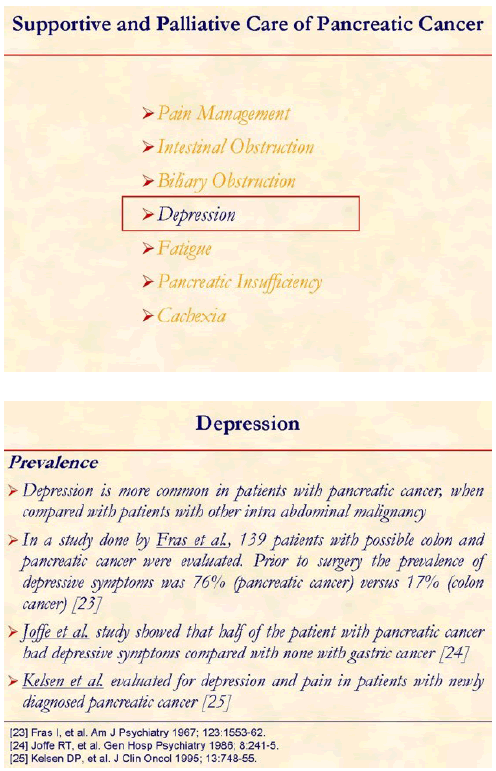
Depression has been demonstrated in 47-71% of patients with pancreatic cancer. The studies mentioned have shown increased prevalence of depression in this disease [23, 24]. The study done by Kelsen et al. had interesting findings [25]. However, they did not evaluate the patients receiving chemotherapy who are more likely to be depressed.
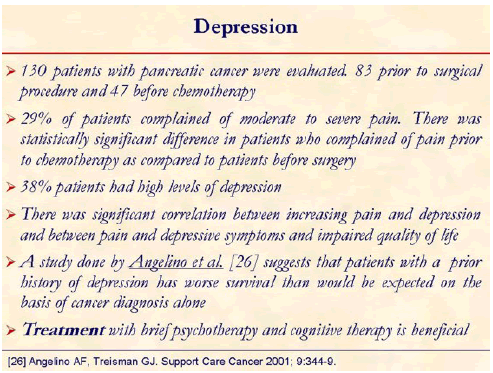
Management of depression depends upon attention to adequate pain control, use of antidepressants and psychological support. [26]
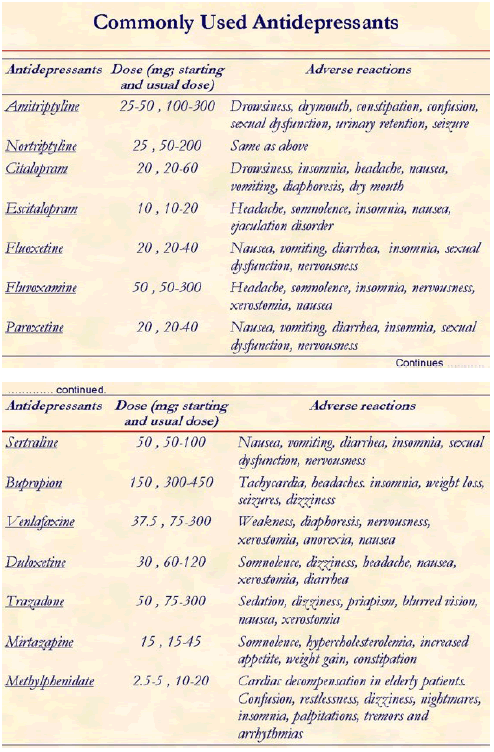
Most commonly used antidepressants are listed with the doses and their common adverse reaction. In general, it is best to start the antidepressants at a low dose and titrate up as the patient tolerates. This approach will help in minimizing side effects and aids in compliance.
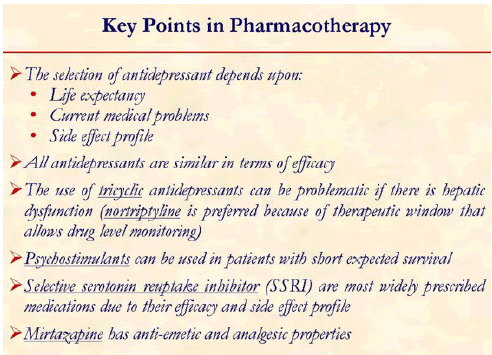 The clinical trials have shown that all the antidepressants are approximately equal in terms of the efficacy. The choice of the antidepressants is dependent on the current medical problems, their side effect profile and life expectancy of the patient. It is important to identify the side effect profile and use it to work for patient benefit. Tricyclic antidepressants cause weight gain, sedation, constipation and urinary retention. So these agents might help someone who is having diarrhea, insomnia and weight loss. Once they are stabilized on an antidepressant, it is important to identify and treat the side effects still bothering the patient. Tricyclic antidepressants have analgesic properties and potentiates the analgesic effects of the opioids. Usually cancer patients with depression are sensitive to tricyclic antidepressants as compared patients with depression alone. SSRI are usually well tolerated, they have lesser side effects as compared to tricyclic antidepressants . Trazadone has sedating properties and is useful adjunct to patients who have annoying insomnia on SSRI. Psychostimulants such as methylphenidate, dextroamphetamine, mofadanil and pemoline can be useful to counteract fatigue, appetite and energy. Pemoline can cause hepatocellular injury and should be used with caution in patient with liver metastasis.
The clinical trials have shown that all the antidepressants are approximately equal in terms of the efficacy. The choice of the antidepressants is dependent on the current medical problems, their side effect profile and life expectancy of the patient. It is important to identify the side effect profile and use it to work for patient benefit. Tricyclic antidepressants cause weight gain, sedation, constipation and urinary retention. So these agents might help someone who is having diarrhea, insomnia and weight loss. Once they are stabilized on an antidepressant, it is important to identify and treat the side effects still bothering the patient. Tricyclic antidepressants have analgesic properties and potentiates the analgesic effects of the opioids. Usually cancer patients with depression are sensitive to tricyclic antidepressants as compared patients with depression alone. SSRI are usually well tolerated, they have lesser side effects as compared to tricyclic antidepressants . Trazadone has sedating properties and is useful adjunct to patients who have annoying insomnia on SSRI. Psychostimulants such as methylphenidate, dextroamphetamine, mofadanil and pemoline can be useful to counteract fatigue, appetite and energy. Pemoline can cause hepatocellular injury and should be used with caution in patient with liver metastasis.
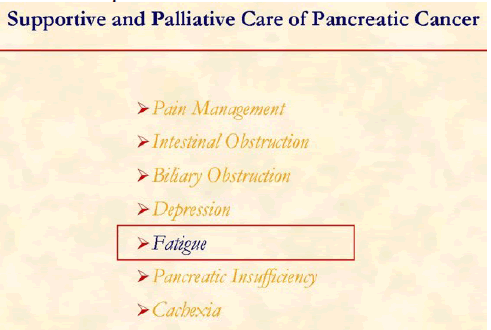
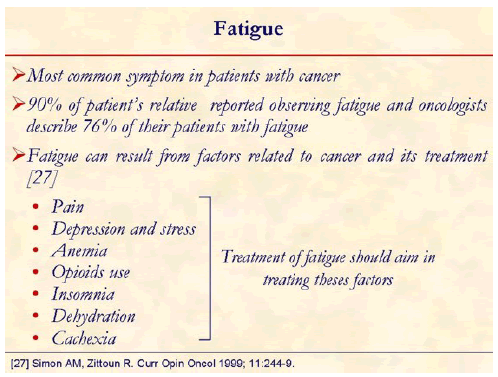
Cancer related fatigue is a subjective experience of tiredness that can influence the patient’s ability to continue with the treatment and eventually can decrease the chance of antitumor effect of chemotherapy. It is important to recognize the several contributing factors outline above in each patient. Treatment is usually difficult and its important to treat the contributing factors. [27]
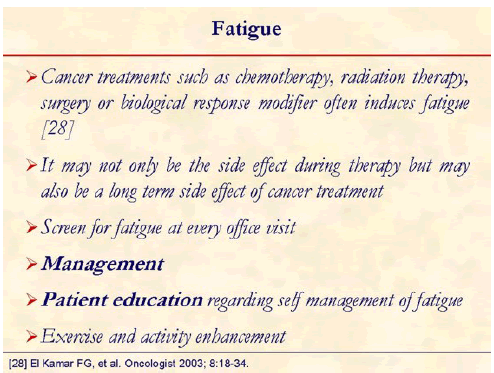
Causes of cancer related fatigue are diverse and are partially explained. Fatigue has been associated with chemotherapy. It has been found that fatigue is usually intense in first few days after chemotherapy. It usually abates over the next few days. Sometimes it can last for prolonged period after the completion of chemotherapy. Cancer related fatigue is a common problem and it should be routinely screening during and after cancer treatment. Patients should be educated about fatigue as a possible side effect of cancer treatment. Some patients can interpret it as a sign of tumor progression, education regarding it can help preventing anxiety. Self management means that patient can prioritize their activities, so that fatigue does not prevent them from performing essential activities. Exercise and activity enhancement has been shown consistently to help in fatigue. It increases the functional capacity so that they can perform their activities with reduced effort. [28]
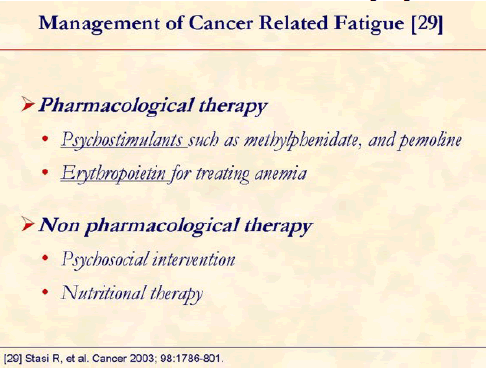
Pharmacological therapy can be helpful in certain subsets of patients. Erythropoietin can improve hematocrit and increase the energy level in patients with anemia. Psychostimulants can reduce fatigue and depression in patients with malignancy. The side effects of methylphenidate and pemoline have been discussed in the depression section. [29]
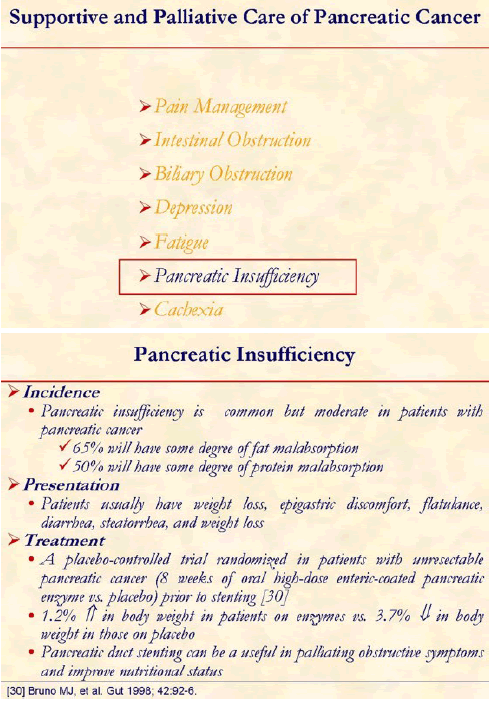
Pancreatic exocrine insufficiency is common in patients with pancreatic cancer, usually after surgery. Pancreatic insufficiency may cause vague abdominal discomfort, pain, abdominal distention, excessive flatus (gas), belching, diarrhea, steatorrhea (fat indigestion) and weight loss. Pancreatic enzyme replacement has a unique role in management. It is obvious that pancreatic insufficiency is likely to be a problem with patients who have undergone surgery to have part of the pancreas removed. However, most non-surgical cancer patients will have a blocked or partially blocked pancreatic duct and so are also likely to have some need of enzyme replacement therapy. The benefit to non-surgical patients has been shown in a trial reported by Bruno et al. in 1998 [30]. It should be considered for most of the patients.
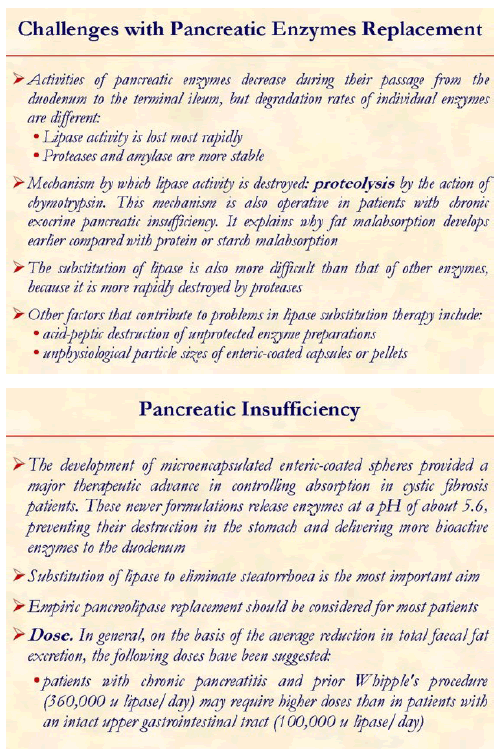
Pancreatic enzyme replacement therapy should be considered if the patient develops any of the symptoms described earlier. Newer enteric-coated have better tolerability and efficacy. Anti-acid medications should make the enzymes more effective.
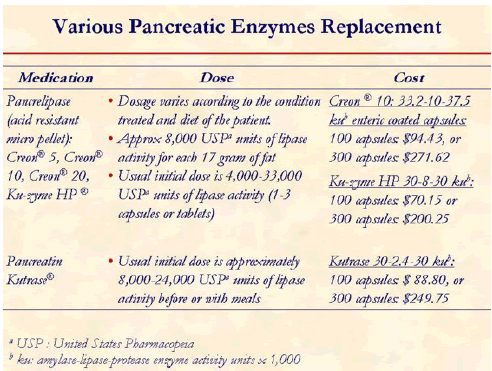
Replacement pancreatic enzymes are available in different formulations and dosages. For instance Creon® is available in dosages of 10,000, 25,000 and 40,000 units of lipase per capsule. So a patient needing a large quantity of enzymes per meal can take a smaller number of high dosage capsules (up to five or six capsules, around 240,000 units of lipase, with meals if necessary). Some patients, e.g. those who have had surgery to remove part or all of the pancreas, may need to take up to 20-30 of the high dosage capsules a day (i.e. 1,000,000 units of lipase). Price of the supplement can be another reason affecting the selection. In addition, if a patient is having problems with bloating despite taking the enzymes, changing to a different formulation may help few patients.
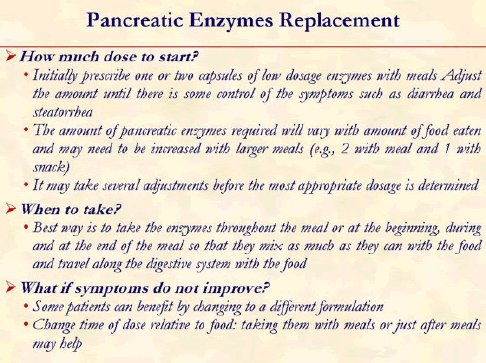
Replacement pancreatic enzymes are available in different formulations and dosages. If a patient needs a large quantity of enzymes per meal, he/she can take a smaller number of high dosage capsules or tablets.
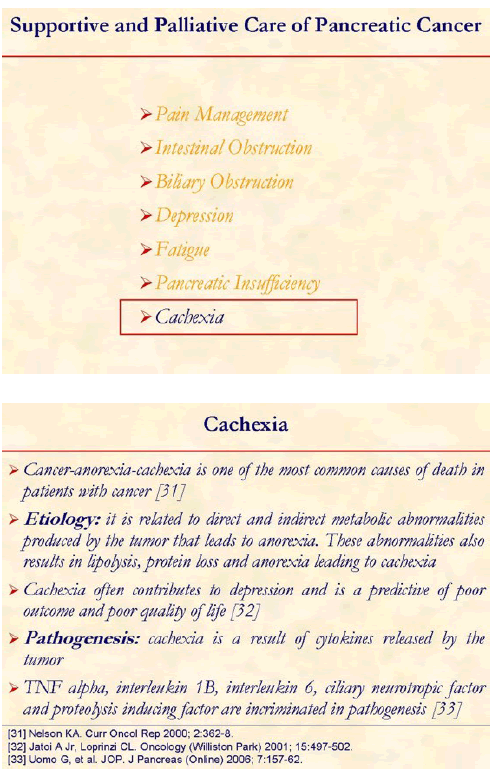
The cancer-anorexia-cachexia syndrome is complex and incompletely understood. Supplemental feeding by parenteral and oral routes does not result in reversal of the cancer-anorexia-cachexia. It is difficult to separate the symptom (anorexia) from the sign (cachexia) in the dynamic process leading to cancer-anorexia-cachexia syndrome. The disease burden does not correlate with cachexia. [31, 32, 33]
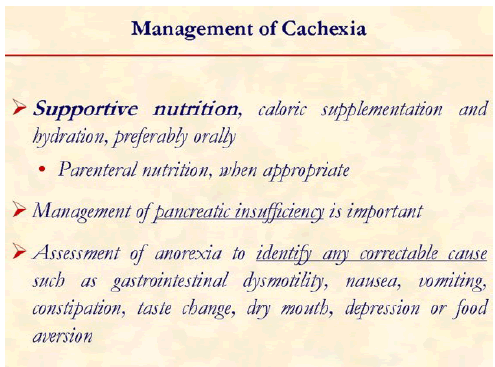
Supportive nutrition with caloric supplementation using oral route is important. This method is associated with lesser side effects as compared to parenteral route. Parenteral route is associated with infection, thrombosis and metabolic abnormalities. It is important to manage the patient for the exocrine pancreatic insufficiency. It is unusual for a patient with anorexia to have single specific contributing factor, when controlled alleviates the anorexia.
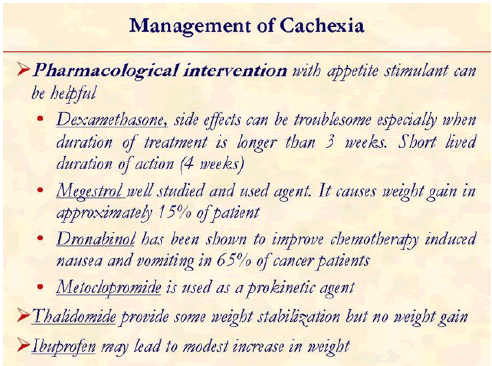
Pharmacological interventions using appetite stimulants, prokinetic agents and newer agents can be helpful. The appetite stimulants such as megesterol, dexamethasone have been shown to act rapidly and increase non fluid body weight in patients with advanced cancer. Dronabinol has been shown to be effective in HIV associated cachexia as well.
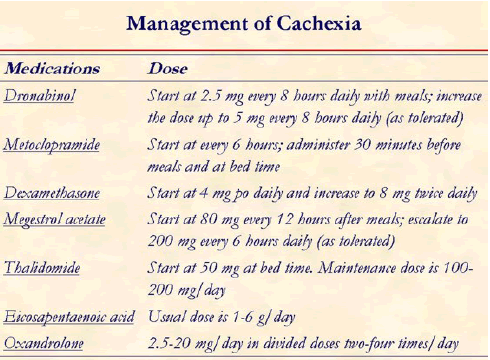
Various drugs, such as dronabinol, metoclopramide, dexamethasone, and others can be used to manage cachexia. Patient’s other co-morbid conditions as well as other medications (drug-drug interaction) should be assesses before prescribing a medication to manage cachexia.
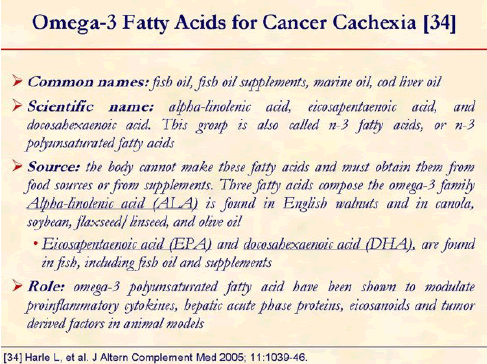
Omega-3 fatty acids are important nutrients that are involved in many bodily processes. Our bodies cannot manufacture these fatty acids and therefore, must obtain them from food sources (or from supplements). There are three fatty acids that compose the omega-3 family: alpha-linolenic acid (ALA), eicosapentaenoic acid (EPA) and docosahexaenoic acid (DHA). It is important to note that omega-3 fatty acids are different from the omega-6 fatty acids, which are also essential. Unlike omega-3s, omega-6s are quite plentiful in the typical US diet. [34]
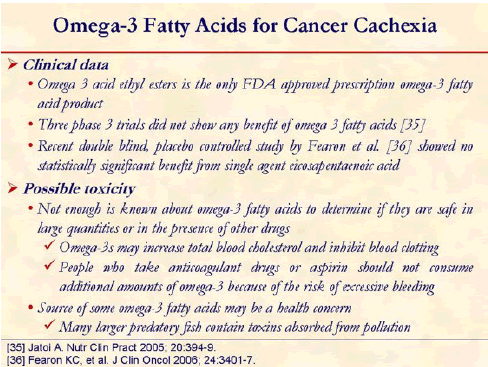
Omega-3 acid ethyl esters is the only FDA approved prescription omega-3 fatty acid product. [35, 36]
